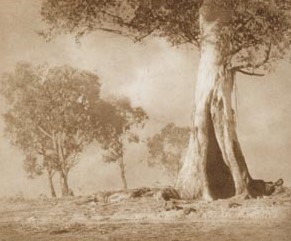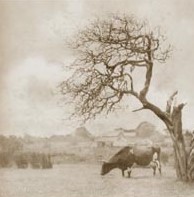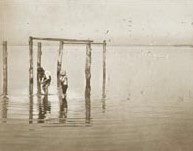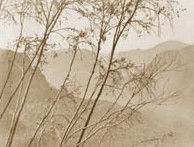KIICHIRO ISHIDA
Born 1886 Died 1957 - Akita Prefecture, Japan
The following is from the MUSEUMS OF HISTORY NSW
The delicate and serene photographic work of Kiichiro Ishida, the Japanese photographer invited to join the highly prestigious Sydney Camera Circle in 1921 was the focus of an exhibition at the Museum of Sydney.
Ishida, whose works had not been seen in Australia since that time, worked along side such luminaries as Harold Cazneaux, Henri Mallard and Monte Luke, all members of the Sydney Camera Circle. The Sydney Camera Circle formed in 1916 as a small group of photographers working to promote pictorial photography using Australian sunlight.Contributing to the work of this revolutionary photographic movement, Ishida produced exceptional works of the Australian landscape and Sydney’s urban environment between 1919 and 1923.
"Ishida’s photographs from the Sydney period express a clean beauty of the vast, dry, bright landscapes of Australia, or views of the city streets and people who inhabit them, and in all of them we can feel the enjoyment he obviously derived from creating them", said Yuri Mitsuda, curator, The Shoto Museum of Art, Tokyo.
Kiichiro Ishida was born in 1886 and died in 1957 in Akita Prefecture, Japan. In 1919 he was transferred to the Sydney branch of a large Japanese wool trading company in Macquarie Place. Ishida bought his first camera at this time, becoming engrossed in photography after meeting Ichiro Kagiyama, a Japanese migrant and well-established professional photographer living in Sydney.
"Ishida stayed in Australia until the end of 1923 and during this antipodean period his photography matured quickly. He produced idyllic and poetic landscapes, beach scenes, portraits, studies of trees and the harbour. When Ishida left Sydney to return to Japan he asked the Circle members for some of their best prints to take with him. He exhibited these along with his own photographs at the Shiseido Gallery in Ginza where they were well received", said Judy Annear, Senior Curator Photography, Art Gallery of New South Wales.
Ishida and his wife Ei joined a thriving and prosperous Japanese community in Sydney. Wealth from trade allowed Japanese families in Sydney an affluent lifestyle in places like Mosman, Vaucluse, Woollahra and Woy Woy.
Ichiro Kagiyama arrived in Sydney around 1906, and was an influential member of the Photographic Society of New South Wales. He became a significant commercial photographer commissioned to photograph special events and social occasions for the Japanese consul and Japanese trading companies in Sydney. He lived in Sydney for over 30 years, until the outbreak of World War II, and some of his work was also featured in the exhibition.
"The exhibition provided a glimpse, through the personal stories of Ishida and Kagiyama, of a thriving and prosperous Japanese community living in Sydney from the early 1900s to 1941 based around Japanese trading companies, and committed to life and work in Australia", said Beth Hise, Exhibition Coordinator, Historic Houses Trust.
The exhibition showcased 65 of Ishida’s works from Sydney as well as Japan and northern China and 40 photographs by Sydney Camera Circle members, including 21 works by Harold Cazneaux.
Based on an exhibition organized by The Shoto Museum of Art, Tokyo, Japan, supported by the Art Gallery of New South Wales.
The following is from pnaumann.net
Kiichiro Ishida and the Sydney Camera Circle
MODERNISM / JAPONISM in PHOTOGRAPHY 1920's-40's
In 1919, Kiichiro Ishida was posted to Sydney, Australia, to work for the Okura-Gumi trading company. It was here that a Japanese photographer friend also living in Sydney introduced him to the art of photography. Within a year, Ishida's photographic work was of such a standard that it was accepted for exhibition at the prestigious London Salon of photography organized by the Royal Photographic Society.
Within two years, he was invited to join the influential Sydney Camera Circle. The aim of this small group was to further photography as an art form and to exhibit their work internationally. An exhibition at the Shoto Museum displays the work of Ishida as well as many of the works of fellow Sydney Camera Circle members. Among these are the noted works of Harold Cazneaux, a seminal figure in the history of Australian photography.
Photography had its roots in a Victorian romantic pictorialism. Exaggerated dramatic poses and gloomy, dark landscapes characterized the dominant style at the turn of the 19th century. The British Royal Photographic Society, asserted a strong stylistic influence. The Sydney Camera Circle members were intent on creating a distinctly Australian style. This was characterized by an emphasis on sunlight, atmosphere, nature and people in everyday scenes of work and leisure. Ishida was quickly influenced by their style and in particular by the work of Harold Cazneaux.
Ishida's photography is noted for his use of the Bromoil print process. This process, developed early in the 19th century consisted of a positive image on treated paper. It was based on the principle that oil and water do not mix. Once an enlargement was made, it was bleached to remove the black silver image. Greasy inks of various colors were then applied to the damp paper using special soft brushes. The raised gelatin areas, damp with moisture, repelled the oil-based inks.
Various tones and textures could be attained by careful brushwork. The process resulted in soft atmospheric and delicate works of which Ishida was a master. He was responsible for the reinvigoration of this process in the Sydney Camera Circle as well as in Japan. Many of the Sydney Camera Circle member's works are on display in this comprehensive exhibition.
Ishida's works differed from his colleagues in the Circle. A spare composition and lack of strong perspective characterize his images. His works such as The Shell Gathers (1922), The Gums (1923), and Mountain Decoration (1923) display a distinctly Japanese aesthetic; a flatness and a composition more akin to Sumi-e (scroll painting) or Ukiyo-e (woodblock prints).
After five years in Sydney Ishida returned to Japan and continued exhibiting his work, as well as, exhibiting the work of the Sydney Camera Circle that he had brought with him. Later, Ishida also spent time in Tianjin and Beijing where he photographed the villages, peasants, and the rural landscape of China. On his return to Japan after the second World War Ishida stopped his photography and devoted himself to running the family business and local politics.
Many Japanese artists traveled to Europe to further their artistic careers and education. Many were part of art movements such as surrealism, but few are noted in the history texts or recognized outside of Japan for their achievements. This exhibition is unique in that it traces the origins of a Japanese artist who initially achieved acclaim overseas and then became an important stylistic influence in Japan.
Kiichiro Ishida's work has been recognized in Australia and Japan. Both countries sat on the edge of the dominant western European artistic tradition. This exhibition is a unique opportunity to trace the career of an influential Japanese photographer and to see the works of an important artistic group who explored a new vision for photography.




image 1: Kiichiro Ishida, The Gums, 1923
image 2: Kiichiro Ishida, Australian Dairy Farm, 1922
image 3: Kiichiro Ishida, The Shell Gatherers, 1922
image 4: Kiichiro Ishida, Mountain Decoration, 1923